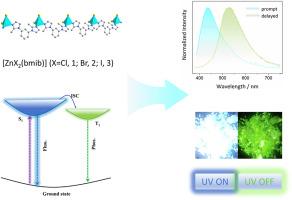Halide modulated room-temperature phosphorescence from one-dimensional metal‒organic halides for time-resolved anti-counterfeiting
IF 3.3
3区 物理与天体物理
Q2 OPTICS
引用次数: 0
Abstract
Room-temperature phosphorescence (RTP) materials have shown widespread applications in optoelectronic devices, biological imaging, molecular switches, safety systems, etc. Here, we report the design and synthesis of a series of metal‒organic halide materials with regulated phosphorescence and fluorescence dual emission properties. Their dual emission ratio and RTP lifetime can be facilely tuned by the halide substituent synthesis. Bright afterglow with various emission duration for the investigated materials can be identified by the naked eyes. DFT calculations reveal that the excited states exhibit halide‒ligand charge transfer (XLCT) character and the halide atoms play crucial role in their luminescence properties. Based on their regulatable dual emission and afterglow properties, a time-resolved anti-counterfeiting application is developed and avoids the over-dependence on equipment, which further provides feasible design strategy of advanced portable anti-counterfeiting technology.

一维金属有机卤化物的卤化物调制室温磷光用于时间分辨防伪
室温磷光(RTP)材料在光电器件、生物成像、分子开关、安全系统等领域有着广泛的应用。在此,我们报告了一系列具有调节磷光和荧光双发射特性的金属有机卤化物材料的设计与合成。它们的双发射比和 RTP 寿命可通过卤化物取代基的合成进行方便地调节。肉眼可以识别所研究材料不同发射持续时间的明亮余辉。DFT 计算表明,激发态具有卤化物-配体电荷转移(XLCT)特性,卤化物原子在发光特性中起着关键作用。基于其可调节的双发射和余辉特性,开发了一种时间分辨防伪应用,避免了对设备的过度依赖,进一步为先进的便携式防伪技术提供了可行的设计策略。
本文章由计算机程序翻译,如有差异,请以英文原文为准。
求助全文
约1分钟内获得全文
求助全文
来源期刊

Journal of Luminescence
物理-光学
CiteScore
6.70
自引率
13.90%
发文量
850
审稿时长
3.8 months
期刊介绍:
The purpose of the Journal of Luminescence is to provide a means of communication between scientists in different disciplines who share a common interest in the electronic excited states of molecular, ionic and covalent systems, whether crystalline, amorphous, or liquid.
We invite original papers and reviews on such subjects as: exciton and polariton dynamics, dynamics of localized excited states, energy and charge transport in ordered and disordered systems, radiative and non-radiative recombination, relaxation processes, vibronic interactions in electronic excited states, photochemistry in condensed systems, excited state resonance, double resonance, spin dynamics, selective excitation spectroscopy, hole burning, coherent processes in excited states, (e.g. coherent optical transients, photon echoes, transient gratings), multiphoton processes, optical bistability, photochromism, and new techniques for the study of excited states. This list is not intended to be exhaustive. Papers in the traditional areas of optical spectroscopy (absorption, MCD, luminescence, Raman scattering) are welcome. Papers on applications (phosphors, scintillators, electro- and cathodo-luminescence, radiography, bioimaging, solar energy, energy conversion, etc.) are also welcome if they present results of scientific, rather than only technological interest. However, papers containing purely theoretical results, not related to phenomena in the excited states, as well as papers using luminescence spectroscopy to perform routine analytical chemistry or biochemistry procedures, are outside the scope of the journal. Some exceptions will be possible at the discretion of the editors.
 求助内容:
求助内容: 应助结果提醒方式:
应助结果提醒方式:


